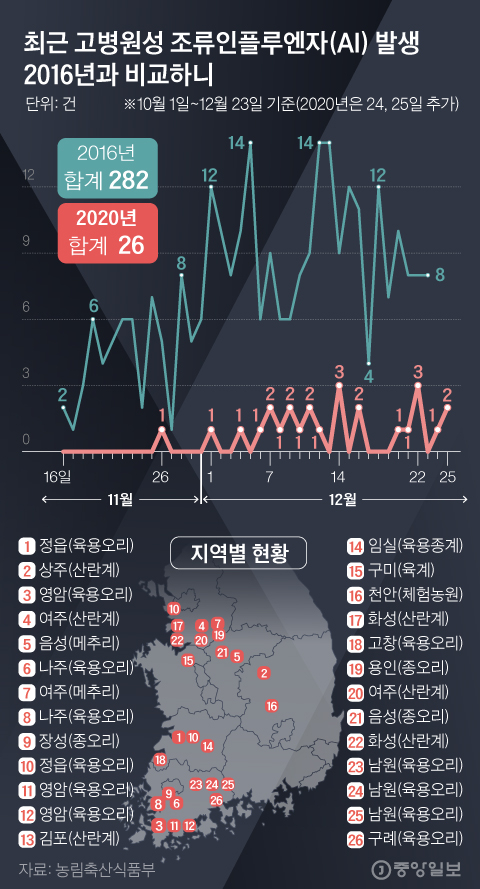On the 25th of Christmas, the tensions of the quarantine authorities increased. The number of new coronavirus infections (Corona 19) has occurred, and highly pathogenic avian influenza (AI) has not stopped spreading nationwide. Although the AI virus is already spreading all over the country, the government’s goal is to prevent further inflows into poultry farms.

Avian influenza outbreak status. Graphic = Reporter Kim Kyung-jin [email protected]
On this day, the AI Central Accident Control Center confirmed H5N8 type highly pathogenic AI at duck farms in Namwon, Jeollabuk-do and Gurye, Jeollanam-do. This is the 25th time AI has occurred in farms this year (26th including Cheonan Experience Farm). A duck farm in Jeongeup, Jeollabuk-do was confirmed last month, and AI, which had been silent for two years and eight months, began to spread again.
One tenth of 2016… I can’t be relieved though
Compared to 2016, which has suffered the most damage so far, the spread of this year is slow. In 2016, the first farmhouse confirmation occurred on November 16, ten days earlier than this year. By the following year, 353 poultry farms across the country were infected with AI, and 3,379 million chickens and ducks were killed. In particular, the damage of laying hens (chicken that lay eggs) raised in cramped breeding facilities increased, and egg prices soared. At the time, the government belatedly imported eggs from Thailand and other countries, but it was not able to catch the soaring price.
In 2016, since the first outbreak, it was not possible to block further transmission, so 282 farms were confirmed for about 40 days. During the same period this year, 23 farms were confirmed. That doesn’t mean you can rest assured. The number of highly pathogenic AI outbreaks in wild birds, such as migratory birds that carry viruses on farms, is 37 this year, more than in 2016 (32). Unlike in the past, there have already been two cases of wild bird infection in Jeju Island this year.
Killing 8.4 million this year… Concerns about price surge

On the 15th, a chicken and duck meat stand in a large supermarket in Seoul. yunhap news
Damage is not limited to AI-prone farms. This year, the government is killing all poultry raised within 3km of the outbreak farm as a preventive measure. By the last 24th, 61,000,000 chickens, 92,000 ducks, and 1.293,000 quails were buried in the ground. Poultry farms within a 10 km radius of the occurrence farm must be restricted from movement for 30 days and undergo AI testing.
The government is in a position that there is no problem with the price of eggs and chicken meat yet. According to the Ministry of Agriculture, Food and Rural Affairs statistics, on the 24th, the prices of eggs (special eggs) and chicken production areas rose 3.6% and 4.5%, respectively, compared to the previous year. However, the government interpreted that the recent increase in household demand due to the strengthening of social distancing also affected the price increase. In terms of consumer prices, chicken prices have fallen from a year ago, and egg consumer prices are also maintaining the same level as before at 1899 won per 10 pieces.
The problem is duck. Due to the decrease in supply, the price of duck meat rose 49.7% to 2,105 won from the 26th of last month (1406 won per kg) when AI first occurred. This is a 55.4% increase from last year. An official from the Ministry of Agriculture and Food said, “Considering the number and inventory of chickens and ducks raised this year, domestic supply is sufficient.”
Sejong = Reporter Seongbin Lim [email protected]
